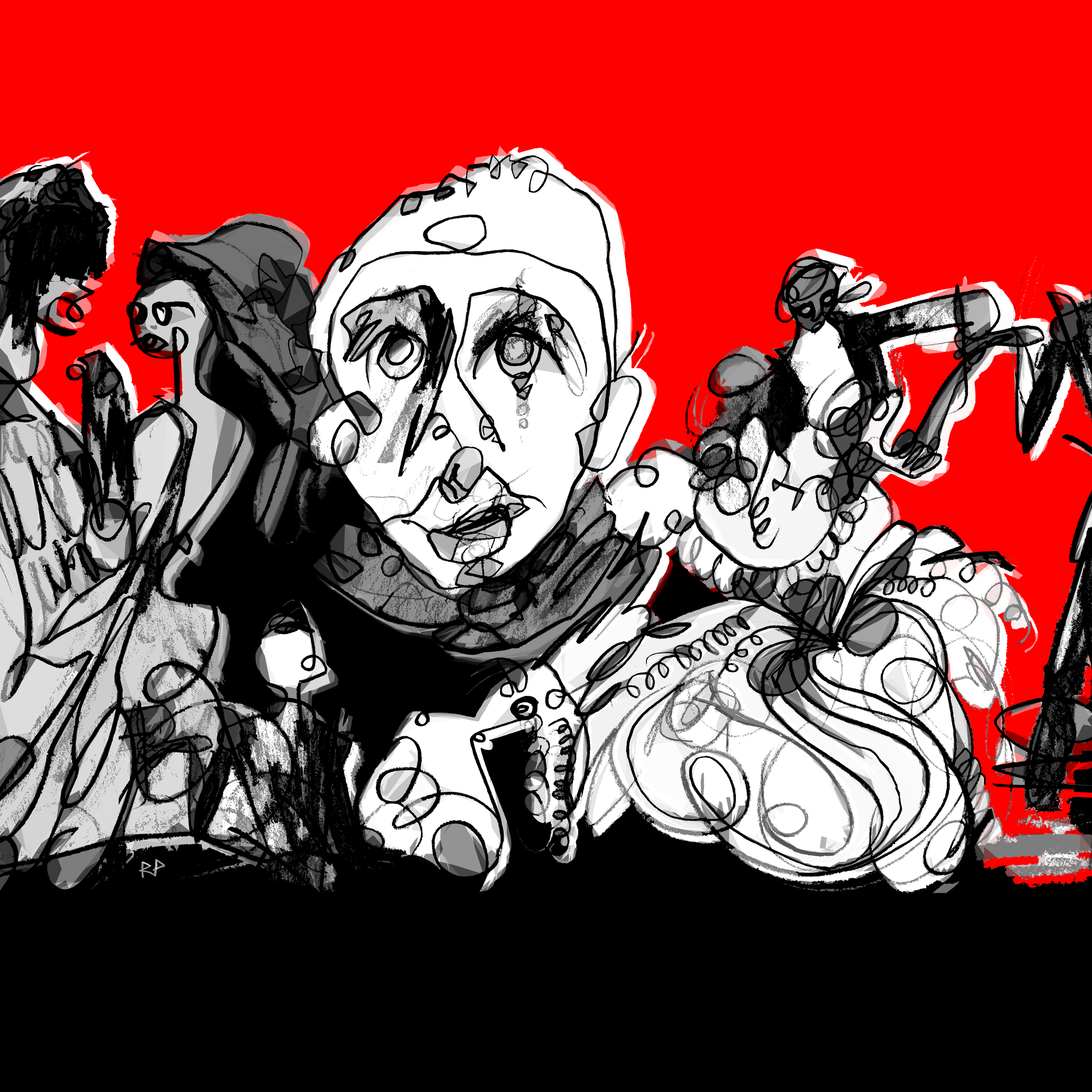Lost In A Crowd
Ryan Prinz
“There’s a glimmer in their eyes, but also a little bit of a tear.”
Interview by C. VanWinkle
April 28, 2022
Can you start by describing the piece that you responded to?
I responded to a poem titled “Waltz”. It was the emotional aspect of the poem that really inspired me. As an artist, emotions and modes of expression tend to get a reaction out of me. I think it’s that way for a lot of people. I was really touched by the heartbreak, the sadness, and the isolation that the writer evoked through their written words. They did a great job expressing themselves and created a beautiful story within such a short space.
Yeah, it's not huge.
And for me that made it more impactful. It distilled a powerful sense of loneliness and being out of place. I got the feeling of someone who might have moved from one part of the world to another and was experiencing cultural confusion in a way. You know, not knowing where you fit in, wanting to fit in but also wanting to maintain who you are. As a queer person, I immediately picked up on that. I could relate to it, maybe not in the exact way they meant, but I think the power of the poem is that it’s universally relatable.
Was it significant to you that it was in two languages?
I thought that was awesome. Maybe that’s where I picked up that feeling of homesickness, but then also the excitement of being in a new place and the confusion of figuring out where you're at. The fact that it was written in two languages planted that seed. I imagine that it was written in Portuguese first and the poet probably translated it themselves, which is really cool because it's more personal to them. It's very interesting how things can have different meanings in different languages. It definitely influenced my interpretation of the poem. I was happy I got to experience both versions, because it gave me a window into the author.
So you read this piece. You had feelings. What happened next?
I didn't want to rush. Sometimes my process is more immediate, which is typically fueled by more of an intense emotional response, and I just let it out onto the paper. But for this one I really wanted to go slow, to think about it.
The poem is centered around a ballroom dance, a Waltz. Initially, I was pulling reference photos from Victorian ballroom scenes – all very dramatic and full of dynamic poses. They were showing joy and love, very romantic depictions of couples. Then you have the poem that is about this person who is, in my head, sitting on the sidelines, watching all of this happen, having this dreamy, romantic vision of what life could be. Maybe that speaks to the fact that I recently moved. I’m dealing with things in my personal life, understanding new places and new people. I think that influenced my reading of the poem. I try to harness what I'm feeling. That's the most important thing. When I sit down, I don't know what it's going to look like. I don’t try to dictate things. It's really a fluid process.
It looks like it's a combination of traditional and digital media. What's your process like?
I love talking about this! Process is super fun for me. My background is in graphic design, which is how I make a living. I also have a background in illustration. I really try to let my process develop naturally; I never want to force anything. Here’s how my process has evolved so far: I love to start with the physical, usually pencil sketching. Then I scan the sketches and do some tweaking in Photoshop, adding some planes of color or shadows for depth. Usually all of that is based off of the shadows and line work that's already been established in physical drawing. I never want to be someone who relies completely on a computer to do something, but I do love to see the different ways I can interpret my own work through digital manipulation. The fun part is being able to experiment. The eclecticness of combining the physical and the digital is a theme that I’m pretty obsessed with. Translating things from one to the other is, in a way, similar to translating a poem into an art piece.
How does this piece relate to the rest of your work?
Lately, I've been focusing a lot on my figure studies, really exploring form and dynamic poses. In that sense, this was all about dance, which was perfect. I love capturing movement, so in that way it was a nice fit. So many great artists in history have used dancers as a subject because they’re so dynamic and exciting to capture. But then the poem was so expressive and emotional, which is the other component that I’m always drawn to. I was feeling it. I felt that the writer was excited to be experiencing all these new things, all this romance and action going on around them. But it’s that bittersweetness, you know, the sadness that comes with change. There's a glimmer in their eyes, but also a little bit of a tear.
Oh, that's beautiful. What are some other things that inspire your work?
I’m always really inspired by design and graphics. I like really stark, graphic imagery. No doubt this comes from my background as a designer. I also tend to be drawn to things like woodcuts, crafts, fashion, films, and even advertisements. I love when things are subversive, a little bit off.
How was it working from a prompt?
I had a great time with it. The poet gave me their work to interpret, which is very trusting. That's what you do as a creative person: you put your work out there and other people pick it up and reinterpret it. Working from a prompt is just that. This poem really was an awesome conversation starter. All inspirations are prompts, in a way.
Is there anything else you wanted to say that I didn't ask for?
You really only gave me one instruction, which was to interpret this poem in my own way. I loved it being that open. The great thing about Bait/Switch is that it gave me room to relax and just create, to be a part of a collaboration without having to overthink things. It was very fun.
Now that you’ve done this for the first time, what would be your advice for someone else approaching this project?
Honestly, my advice would be to go into it with an open mind. Don't let expectations dictate your process. The thing that I gained from this was the conversational component. Even without having a conversation with the poet, I felt like I was talking with them. Embrace the connection between yourself and other artists, which is what Bait/Switch is all about. Be open to new ideas and the unexpected. Go with the flow and let it lead you to a cool place.
Call Number: C70PP | C71VA.priLo
Ryan Prinz is a queer artist currently based in Boston, MA. His mixed media approach explores the codependent relationship between physical and digital works of art. He’d self-describe as an obsessive romantic with an unhealthy dose of unrelenting angst.





